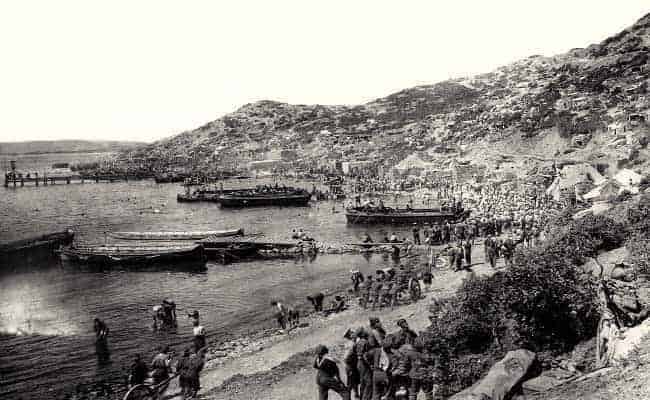The Battle of Gallipoli, also known as the Dardanelles Campaign, was one of the most disastrous Allied campaigns during World War I. Launched on the shores of the Turkish Gallipoli peninsula by the Aegean Sea from late April 1915 to early January 1916, it was an Allied attempt to open a third front and control the sea route from the Mediterranean to the Russian Empire. It was also the first and largest amphibious attack at the moment in history. Followed by failed naval attacks, confusing orders and confidence of superiority, the Allied Forces composed of British, French, Australians, Indians and New Zealanders suffered a major loss. Lack of Intel, food, water, knowledge of the peninsula, sanitary conditions, indecision, and enemy resistance ultimately hindered success.
Six months after the start of the war, the Allied Forces had made little progress and suffered many casualties. Knowing defeat to be at hand, the British command gave orders to evacuate the forces, which began in December 1915 and ended on January 9th, 1916 after a quarter of a million casualties. Veterans of the war remembered it as a terrible place to have served. The Ottoman Empire, part of the Central Powers, scored a major victory when it was over. From that event, we have covered in this post ten reasons why the Battle of Gallipoli is considered one of the worst fighting fronts of the First World War.
10. Early Engagements Failed

One month before the landing began, Winston Churchill, the First Lord of the Admiralty, planned to use the navy to bombard the Dardanelles and empty the Strait of Resistance. With their belief that the Turks would be an easy target, and that minimal force would be needed for success, the British troops commanded by Vice Admiral Carden (head of the British fleet anchored off of the Dardanelles) opened up the first attack on Turkish positions in the Dardanelles.
Although their initial attack managed to destroy the outer forts at Sedd-el-Bahr and Kum Kale, the passage at Strait was heavily mined by the Turkish navy and troops who were set up in other forts and along the shores. Mine sweepers were sent to clear up the zone but due to the great unanticipated resistance by the Turks, they were not able to clear much of the mines. When four old French and six English battleships approached to enter the Strait on March 18, 1915, three of them were sunk, and two others crippled after a few hours of heavy attacks by mines and guns. They were only able to take down a few forts. After much hesitation and losing the initiative, the battleships retreated, allowing the Turks to reinforce the area. After the defeat, Carden collapsed through ill health and was replaced by Rear-Admiral Robeck.

